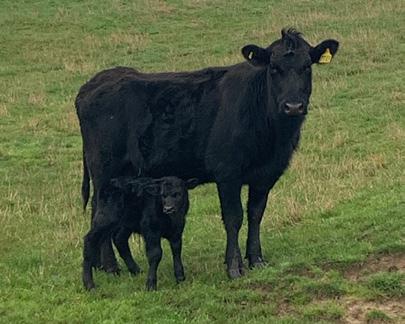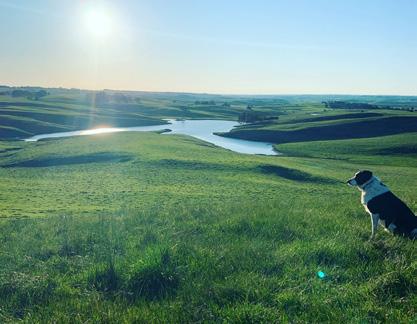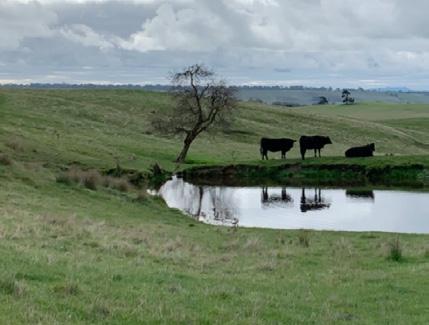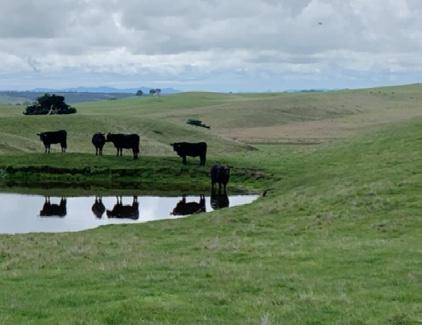
6 minute read
Making the switch to Angus
Cheyne Twist, Senior Marketing & Communications Officer
It is always a pleasure to learn what young people in the industry are up to and how they are making their mark through hard work - and Jamie Pepper is no exception.


A cattle and beef farmer based in the southwest of Victoria, Jamie Pepper farms his family property, running 1,400ha at Tahara, located 25km west of Hamilton township, with the landscape mix of tableland flat country and undulating, hill country. Jamie has had a long-time affiliation in the beef industry, however, has only in recent years begun his association with the Angus breed. “My family have been beef breeding for decades and in recent years when I returned to the farm, I introduced some Angus cows to our operation.” “They are very much a separate enterprise on the farm, with different calving times and market focus. This is my third year joining Angus cows and I am very slowly growing the herd.” The family’s enterprise is one a many moving parts, with an Autumn calving Hereford herd and a Spring calving Angus herd. They have the diversity of a small Poll Dorset stud, selling 50-70 rams annually, as well as a Merino and Prime Lamb production enterprise. Throwing back to 2020, the Pepper’s purchased their first 19 pregnancy tested in calf Angus heifers via a dispersal sale, and since Jamie has worked to continue to grow their Angus herd from the current 8% share hold. “My long-term plan is to continue to grow my Angus herd and slowly decrease Hereford numbers,” said Jamie. For their first joining season, Jamie utilised an artificial insemination program for his herd of Angus. He joins heifers at 15 months of age, which ensures they calve down at 2 years. “Because I only have a small herd and I want to increase numbers through natural increase, I thought using AI technology is a great way of getting positive genetic gain in my herd,” Jamie.
“My AI programs for 2020 and 2021 were quite successful and I will AI my cows again in 2022. AI technology is crucial so I can get the best genetics and grow my herd as every heifer counts.” Following their AI round, Jamie joins the females for 6 weeks or two mating cycles to cover the animals that were unsuccessfully AI’d. Joining in early November, Jamie ensures there is plenty of grass around and that the cows are in great condition during the period. “My key drivers of production are to calve starting late August to avoid the cold and lack of grass growth in early August. I also wean at a time in early March where I don’t have to feed the cow and calf, rather just the weaned calves and the cows can make do on the rank grass in other areas of the farm,” said Jamie. “I’m very much focused on timings for the least number of inputs I have to put into the cows, but still maintaining a high level of animal production. This is understandably season dependent.” When it comes to bulls suitable to his program, Jamie has a number of key considerations that he takes into account firstly when selecting the bulls, and then eventually integrating them into the herd. “I like to purchase bulls which are from a similar geographical area to where I farm. Fortunately, in the western district of Victoria, we are blessed with wonderful Angus studs, so I don’t have to travel too far to buy a good bull,” said Jamie. “In terms of integrating them into the herd, I put all new bulls in a small paddock next to the bull paddock for a few days and then I will feed all of the bulls a bale of hay and put the new bull through into the bull paddock. I find the hay keeps all the bulls happily distracted and don’t notice as much a new bull entering the paddock.” When selecting genetics for their herd, Jamie seeks animals that are stylised with a large frame and nice rump, utilising Estimated Breeding Values to ascertain growth weights of progeny.



Jamie Pepper

The Pepper’s herd turns off weaners to sell through the Mortlake Saleyards, aiming at selling steers at around 14 months of age at approximately 440kg. The herd is EU accredited - which Jamie believes assists in the marketability of their cattle - and partakes in MSA grading. “We have been EU accredited since 2001 and we believe it value-adds to the marketability of our animals. This is perhaps not as prevalent the last few years with very strong and firm cattle prices,” said Jamie. Jamie adheres to low stress management practices with his cattle, citing that “quiet cattle are good cattle". “I am a big believer in my handling technique with cattle. I love quiet cows and handle them as stress-free as I can,” said Jamie. “This is done by never using dogs and single mustering (not having multiple bikes mustering stock in the paddock). In the yards we take our time with drafting and performing the relevant animal husbandry tasks.” As he continues his journey within the beef industry, Jamie is committed to the development of his businesses, and is making a concerted effort to do this through not only practical measures, but also personally through developmental opportunities. “Success for me is growing my new Angus herd steadily over the next few years.” “For our business overall, our short-term goals are to continue increasing our stocking rate and to continue our path of a more environmentally sustainable and diverse farming landscape, by planting trees and fencing off areas identified as eroding and waterways,” he said. “I became an Angus Australia member because I think it is important to support organisations/society’s which help to value-add to our livestock and can also lead to great opportunities, like the GenAngus Future Leaders Program.”
Learning opportunities abound
In 2021, Jamie was selected as part of the GenAngus Future Leaders Program, which saw him take part in a three-day intensive workshop covering business fundamentals. “I applied for GenAngus because I was new to the Angus breed and Angus Australia, and I wanted to gain more skills and knowledge with my Angus herd. As I am very much in a growing phase, informed genetic and marketing decisions are vital to help grow the Angus enterprise,” said Jamie. “I saw the program as a great way to connect with other Angus producers, with a good mix of some who are starting out and some who are more established, to learn more about the Angus breed and for practical guidance to help me make better informed management decisions for genetic selection and marketing.” Reflecting on his main takeaways from the learning experience that was GenAngus, Jamie highlighted presentations that he could directly apply into his developing business. “Firstly, for me was a presentation about genetic selection. This was very practical and forthright and made me realise that I was trying to select genetics based on subjective traits when I need to be selecting genetics based on objective traits (by using Estimated Breeding Values),” he said. “This also made me reflect on what traits were important for me and my unique situation so I can be prepared when selecting semen for my AI program. It’s much better to have a plan and a vision, not just making a selection on a whim and hoping it works out.”










